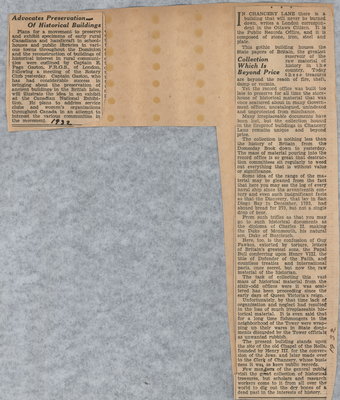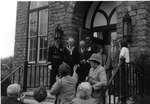Advocates Preservation Of Historical Buildings
- Full Text
Advocates Preservation Of Historical Buildings
===================================
Plans for a movement to preserve and exhibit specimens of early rural Canadiana and handicraft in school-houses and public libraries in various towns throughout the Dominion and the reconstruction of buildings of historical interest in rural communities were outlined by Captain E. Page Gaston, F.R.G.S., of London, following a meeting of the Rotary-Club yesterday. Captain Gaston, who has had considerable success in bringing about the preservation of ancient buildings in the British Isles, will illustrate the idea in an exhibit at the Canadian National Exhibition. He plans to address service clubs and women's organizations throughout Canada in an attempt to interest the various communities in the movement.
===================================
Collection Which Is Beyond Price
--------------------------------
IN CHANCERY LANE there is a building that will never be burned down, writes a London correspondent in the Ottawa Citizen. It is the Public Records Office, and it is composed of stone, iron, steel and plate.
This gothic building houses the State papers of Britain, the greatest reservoir of the raw material of history in the country. Today these treasures are beyond the reach of fire, theft, damp or vermin.
Yet the record office was built too late to preserve for all time the storehouse of historical material that was once scattered about in many Government offices, uncatalogued, unindexed and unprotected from mischance.
Many irreplaceable documents have been lost, but the collection housed in the fireproof buildings in Chancery Lane remains unique and beyond price.
The collection is nothing less than the history of Britain, from the Domesday Book down to yesterday. The mass of material pouring into the record office is so great that destruction committees sit regularly to weed out everything that is without value or significance.
Some idea of the range of the material may be gleaned from the fact that here you may see the log of every naval ship since the seventeenth century and even such insignificant facts as that the Discovery, that lay in San Diego Bay in December, 1793, had aboard bread for 270, but not a single drop of beer.
From such trifles as that you may go to such historical documents as the diploma of Charles II. making the Duke of Monmouth, his natural son, Duke of Bucceleuch.
Here, too, is the confession of Guy Fawkes, extorted by torture, letters of Britain's greatest sons, the Papal Bull conferring upon Henry VIII, the title of Defender of the Faith, and countless treaties and international pacts, once secret, but now the raw material of the historian.
The task of collecting this vast mass of historical material from the sixty-odd offices were it was scattered has been proceeding since the early days of Queen Victoria's reign.
Unfortunately, by that time lack of organization and neglect had resulted in the loss of much irreplaceable historical material. It is even said that for a long time fishmongers in the neighborhood of the Tower were wrapping up their wares in State documents discarded by the Tower officials as unwanted rubbish.
The present building stands upon the site of the old Chapel of the Rolls, founded by Henry III for the conversion of the Jews, and later made over to the Clerk of Chancery, whose business it was to keep public records.
Few members of the general public visit the great collection of historical treasures, but scholars and research workers come to it from all over the world to dig out the dry bones of a dead past in the interests of history.
- Media Type
- Text
- Item Types
- Clippings
- Articles
- Description
- Newspaper articles about preserving historical buildings and local history using as an example the Public Record Office in London.
Two newspaper clippings on a page of scrapbook measuring 22 x 18 cm. Undated but with handwritten "1932" on a margin. Unknown publication.
From Armstrong family collection. - Notes
- The Public Record Office, Chancery Lane in the City of London, was the guardian of the national archives of the United Kingdom from 1838 until 2003, when it was merged with the Historical Manuscripts Commission to form The National Archives, based at Kew.
- Date of Publication
- 1932
- Subject(s)
- Last Name(s)
-
Armstrong
- Local identifier
- QC00618
- Language of Item
- English
- Copyright Statement
- Copyright status unknown. Responsibility for determining the copyright status and any use rests exclusively with the user.
- Contact
- Niagara-on-the-Lake Public LibraryEmail:localhistory@notlpl.org
Website
Agency street/mail address:10 Anderson Lane P.O. Box 430
Niagara-on-the-Lake, ON L0S 1J0
905-468-2023




